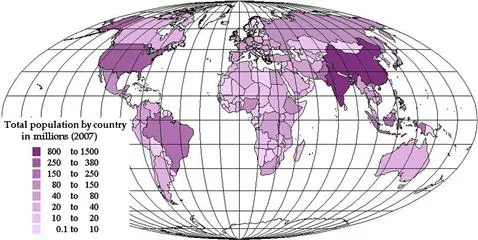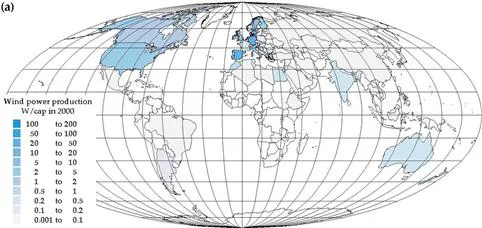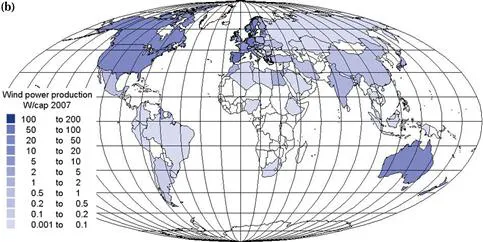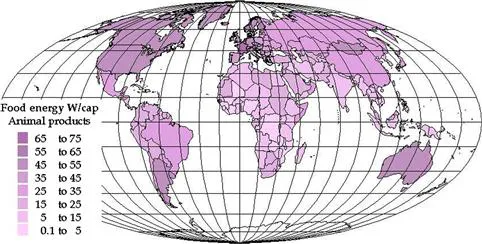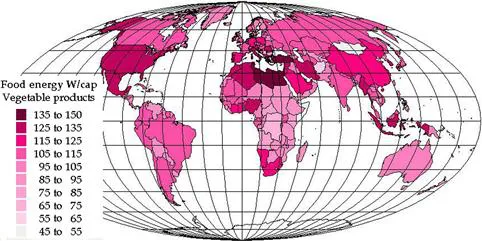1.1 Current Renewable Energy Market
The penetration of renewable energy into the energy system of human settlements on Earth is, from one point of view, nearly 100%. The energy system experienced by the inhabitants of the Earth is dominated by the environmental heat associated with the greenhouse effect, which captures solar energy and stores it within a surface-near sheet of topsoil and the atmosphere around the Earth. Only 0.02% of this energy system is currently managed by human society, as illustrated in Fig. 1.1. Within this economically managed part of the energy sector, renewable energy sources currently provide about 25% of the energy supplied. As the figure indicates, a large part of this renewable energy is in the form of biomass energy, either in food crops or in managed forestry providing wood for industrial purposes or for incineration (firewood used for heat and cooking in poor countries or for mood-setting fireplaces in affluent countries, residue and waste burning in combined power and heat plants or incinerators). The other sources of renewable energy exploited include hydro, wind, and solar. Hydropower is a substantial source, but its use is no longer growing due to environmental limits identified in many locations with potential hydro resources. Passive solar heating is a key feature of building design throughout the world, but active solar heat or power panels are still at a very minute level of penetration. Also, wind has both a passive and an active role. Passive use of wind energy for ventilation of buildings plays a significant role, and active power production by wind turbines is today a rapidly growing energy technology in many parts of the world. The highest penetration, reaching nearly 20% of total electricity provided, is found in Denmark, the country pioneering modern wind technology. Additional renewable energy technologies, so far with fairly small global penetration, include biofuels, such as biogas and geothermal power and heat. As indicated in Fig. 1.1, the dominant direct energy sources are still fossil fuels, despite the fact that they are depletable and a cause of frequent national conflicts, due to the mismatch between their particular geographical availability and demand patterns.
Figure 1.1 Renewable energy in the global energy system (Sørensen, 1992c).
From a business point of view, the total renewable energy flows, including free environmental heat, are, of course, not quite as interesting as the energy that can be traded in a market. Current renewable energy markets comprise both consumer markets and markets driven by government demonstration programs and policies aimed to diminish market distortions. The occasional initial subsidies are part of industrial policy aimed at helping new industry through market stimulation. Compensation for market distortions addresses the fact that conventional energy industries are not fully paying for the negative environmental effects of their products. This is a complex issue, partly because of the difficulty in exact determination of external costs and partly because most countries already levy taxes on energy products that may in part be contributing toward paying for any environmental damage, but often are just a government revenue not specifically used to offset the negative effects associated with using fossil or nuclear fuels (read more about these issues in Chapter 7).
The current penetration of active use of renewable energy in national energy systems is growing, and Figs. 1.3–1.15 show the values for the year 2000, which may serve as a reference year for assessing newer data. In the wind case, where the growth since 2000 is significant, a more recent figure is added; if available, the growth in the annual production is mentioned in the figure caption, showing the national distribution of markets. Because all renewable energy production levels are given in W/cap per country, the 2007 population per country is given for reference in Fig. 1.2 (cf. Fig. 6.1, showing population figures on an area basis). The growth in installed technology and energy production is significant for wind energy and for some biofuels. Renewable energy technologies still confined to niche or subsidized markets also show fairly high growth rates (e.g., solar electricity). The 2000 renewable energy production data, given explicitly in Table 1.1, are suitable for the growth comparisons mentioned.
Figure 1.2 World population, per country, in 2007. (Based on WRI, 2008, UN 2010; for a few non-reporting countries, earlier data plus growth rates have been used.)
Figure 1.3a,b Wind power production. National average values for the years 2000 (a) and 2007 (b) are shown. The 2000 data are from BTM (2001), based on installed capacity and using an average capacity factor of 0.3. The 2007 data are from WEC (2009), giving actual production data, except when not available, in which case the installed capacity is multiplied by an average capacity factor of 0.22. The world average for the year 2000 is 0.92 W/cap, for 2007 it is 2.95 W/cap; for 2008, it has risen to 4.12 W/cap (BTM, 2009).
Figure 1.4 Biomass energy contained in human time-averaged food intake of animal products. National average values for the year 2000 are shown (FAO, 2003). The world average animal-based food intake for the year 2000 is 22.2 W/cap.
Figure 1.5 Biomass energy contained in human time-averaged food intake of vegetable produc...


